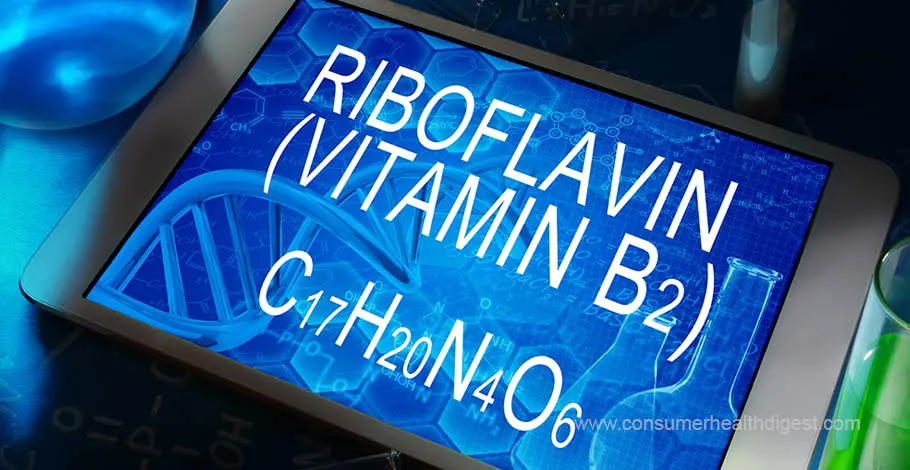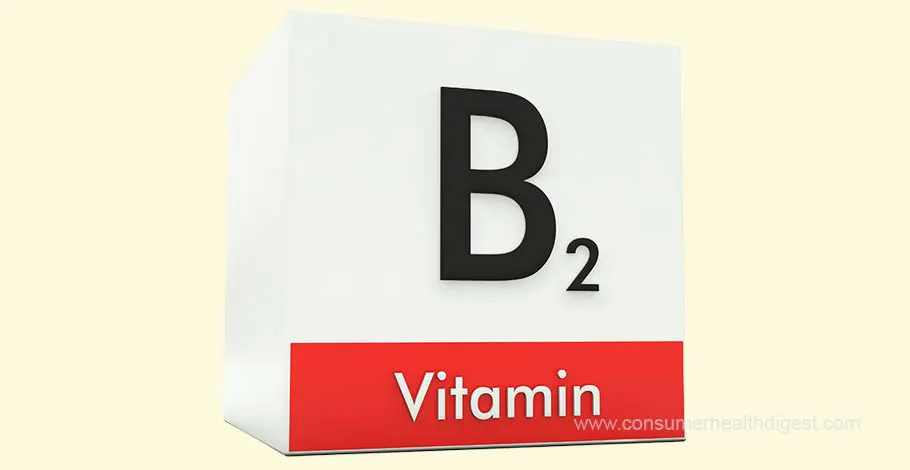In This Review
Riboflavin Overview
The term riboflavin is a combination of the words “ribose,” a simple sugar, and “flavin,” a substance that gives riboflavin a yellow color. Like other B vitamins, riboflavin or B2 vitamin that helps with energy. In addition, it performs many other things, such as ensuring the smooth functioning of the body’s systems, regulating cell growth and proliferation, and helping with memory. [1]

Riboflavin interacts with niacin (essential for the nervous system and gastrointestinal tract) and pyridoxine (crucial for the metabolism of amino acids and starch). Without riboflavin, niacin (Vitamin B3) and pyridoxine (Vitamin B6) would not be able to do their jobs. Riboflavin supplies cells with energy and helps produce the enzymes that release energy from the carbohydrates, fats, and proteins you consume. [2]
Riboflavin Sources
Foods containing riboflavin include avocados, dried roasted almonds, boiled asparagus, turkey breast, minced beef, whole-grain bread, sweet potatoes, swiss chard, and eggs. It is also found in yeast extracts, beans, pork, boiled mushrooms, peas, spinach, pasta, etc. Riboflavin induces no side effects if you take a high dose, so don’t worry too much. Enjoy these foods! Its richest natural sources are milk, eggs, liver, kidneys, and green leafy vegetables. Meat and fish contain small amounts. Cereals (whole or ground) and legumes are relatively poor sources, but due to the amount in which they are consumed, a large proportion of riboflavin contributes to the diet. Germination increases the content of riboflavin in legumes and cereals. Riboflavin is also naturally found in yogurt, okra, bananas, and persimmons. [3]
Riboflavin Supplements
Riboflavin is also available as a supplement, usually prepared along with B-complex vitamins or in multivitamin supplements.
Riboflavin Benefits
A very positive aspect of riboflavin is its ability to reduce the number and severity of migraines in people who often suffer from them. Studies show that this is because people with migraines have low levels of cellular energy in their brains. Riboflavin helps cells make better use of energy, which helps prevent migraines. [4]
Riboflavin is essential in the use of oxygen by the body and the metabolism of carbohydrates, amino acids, and fatty acids. It helps with the adrenal glands, the formation of red blood, the respiration and growth of cells, the production of antibodies, and the maintenance of the digestive tract lining.
Riboflavin also relieves eye fatigue and is believed to help prevent and treat cataracts It is essential during growth (for children) and helps maintain healthy hair, skin, and nails.
An additional riboflavin intake may be needed when taking birth control pills, antibiotics, and alcohol or during strenuous exercise.

Health Benefits of Riboflavin
Side Effects
Riboflavin has the potential for side effects and interactions. The dietary supplement should therefore be taken under the strict supervision of an experienced healthcare professional. Although generally considered safe, high doses above 10 grams per day can damage the eyes due to the sun. If you are taking large amounts of riboflavin, protect your eyes from ultraviolet rays by wearing sunglasses. Possible side effects include itching, numbness, orange or yellow urine, a burning sensation, and increased sensitivity to light. Studies show that long-term intake of vitamin B2 can cause an imbalance of other vital B vitamins.
Deficiencies of riboflavin
Unlike thiamine, riboflavin is stored in the kidneys and liver. Therefore, riboflavin deficiency can last for three or four months. Most people consume a lot of riboflavin, so deficiencies are rare. People who exercise a lot, people with diabetes, the elderly, and riboflavin vegetarian need extra riboflavin. [5]
Riboflavin deficiency symptoms
Riboflavin deficiency causes nausea, dizziness, dermatitis, hair loss, sensitivity to light, insomnia, slow growth, indigestion, burning sensation in the legs, and slow mental reactions. It can also cause eye disorders, skin lesions, inflammation of the tongue and mouth, and cracks and ulcers in the corners of the mouth. Riboflavin deficiency may also be associated with oral-ocular genital syndrome, photophobia, and scrotal dermatitis. [6]
Riboflavin is best taken with B vitamins and vitamin C.
Riboflavin functions
Due to its yellow-orange color, riboflavin is commonly used as a dye in many foods. It is also used to enrich various foods such as breakfast cereals, sauces, pasta, fruit juices, baby food, processed cheeses, dairy products enriched with vitamins, and energy drinks. However, riboflavin is difficult and expensive to incorporate into liquid products because it is not entirely soluble in water. It requires the inclusion of a chemical called riboflavin-5-phosphate, which is a more expensive form of riboflavin. The most noticeable use of riboflavin is in phototherapy (light therapy) in neonatal jaundice or yellowing of the skin and other tissues of the newborn due to increased bilirubin (a byproduct of expected hemoglobin degradation) in the first week of life. [7]
Dosage
Although riboflavin is standard and critical for your body, you only need it in small amounts. The recommended daily intake of riboflavin is also based on calorie intake, so the more you eat, the more you will need. High doses of riboflavin have no proven toxicity. In addition, the body’s limited ability to absorb riboflavin eliminates the possibility of injury. However, any excess of this vitamin is excreted in the urine – it turns yellow – but it is harmless.
You usually need about 0.6 mg of riboflavin for every 1,000 calories you consume. The average intake for a woman should be higher than one milligram, and the average intake for a man should be higher than 1.3 milligrams. Adult men and women need 1.3 mg and 1.1 mg of riboflavin per day, respectively. For pregnant and lactating women, it is recommended to increase the dose to 1.4 to 1.6 mg per day.
FAQs
Q: What does riboflavin do?
A: Vitamin B2, also called riboflavin helps the body convert food (carbohydrates) into fuel (glucose), which manufactures energy. It also helps the body metabolize fats and protein. [8]
Q: What vitamin is riboflavin?
A: Vitamin B2, also called riboflavin, is required to help disintegrate proteins, carbohydrates, and fats. It also helps the body to use oxygen.
Q: A deficiency of riboflavin is referred to as?
A: Riboflavin deficiency is known as ariboflavinosis. Along with insufficient intake, causes of riboflavin deficiency can consist of endocrine abnormalities (like thyroid insufficiency) and some other diseases.
Q: How much riboflavin per day?
A: The recommended dietary allowance (RDA) of riboflavin for adult males daily is 1.3 mg, 1.1 mg for women daily, 1.6 mg for lactating women daily, and 1.4 mg daily for pregnant females.
Q: Is riboflavin water soluble?
A: Riboflavin is a water-soluble, yellowish, luminous compound. The principal form of the vitamin is as an essential component of the coenzymes. [9]
Q: What is riboflavin made of?
A: Riboflavin (vitamin B2) is a water-soluble vitamin produced by all plants and most microorganisms and is essential for growth. [10]
Q: Is riboflavin fat-soluble?
A: No. There are only four vitamins that are fat-soluble, which means they dissolve in oil. Nine water-soluble vitamins are found in the human diet.
10 Sources
We review published medical research in respected scientific journals to arrive at our conclusions about a product or health topic. This ensures the highest standard of scientific accuracy.
[1] https://ods.od.nih.gov/factsheets/Riboflavin-HealthProfessional/[2] Parra M, Stahl S, Hellmann H. Vitamin B? and Its Role in Cell Metabolism and Physiology. Cells. 2018;7(7):84. Published 2018 Jul 22. doi:10.3390/cells7070084
[3] Nkhata SG, Ayua E, Kamau EH, Shingiro JB. Fermentation and germination improve nutritional value of cereals and legumes through activation of endogenous enzymes. Food Sci Nutr. 2018;6(8):2446-2458. Published 2018 Oct 16. doi:10.1002/fsn3.846
[4] Riboflavin: https://medlineplus.gov/druginfo/natural/957.html#:~:text=Taking%20high-dose%20riboflavin%20by,pain%20experienced%20during%20a%20migraine.
[5] Yang FL, Liao PC, Chen YY, Wang JL, Shaw NS. Prevalence of thiamin and riboflavin deficiency among the elderly in Taiwan. Asia Pac J Clin Nutr. 2005;14(3):238-43. PMID: 16169834.
[6] Riboflavin: https://www.newworldencyclopedia.org/entry/Riboflavin
[7] Gromisch DS, Lopez R, Cole HS, Cooperman JM. Light (phototherapy)--induced riboflavin deficiency in the neonate. J Pediatr. 1977 Jan;90(1):118-22. doi: 10.1016/s0022-3476(77)80784-1. PMID: 830875.
[8] Riboflavin: https://ods.od.nih.gov/factsheets/Riboflavin-HealthProfessional/#:~:text=sheet%20on%20Riboflavin.-,Introduction,available%20as%20a%20dietary%20supplement.
[9] National Center for Biotechnology Information (2023). PubChem Compound Summary for CID 493570, Riboflavin. Retrieved March 17, 2023 from https://pubchem.ncbi.nlm.nih.gov/compound/Riboflavin.
[10] Front. Bioeng. Biotechnol., 12 November 2020 Sec. Industrial Biotechnology Volume 8 - 2020 | https://doi.org/10.3389/fbioe.2020.570828







 This article changed my life!
This article changed my life! This article was informative.
This article was informative. I have a medical question.
I have a medical question.
 This article contains incorrect information.
This article contains incorrect information. This article doesn’t have the information I’m looking for.
This article doesn’t have the information I’m looking for.